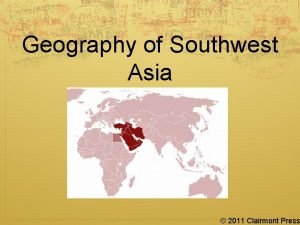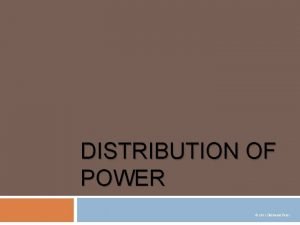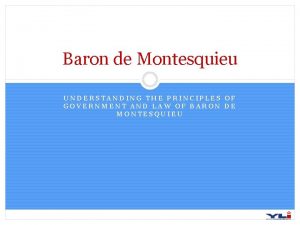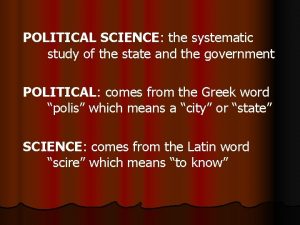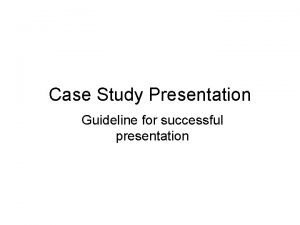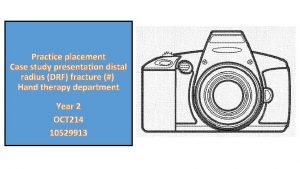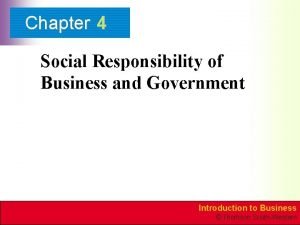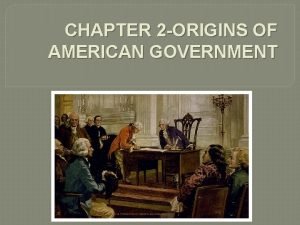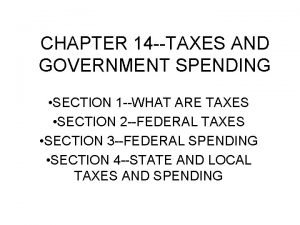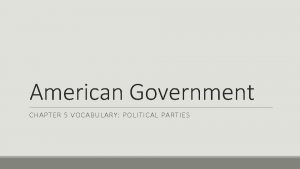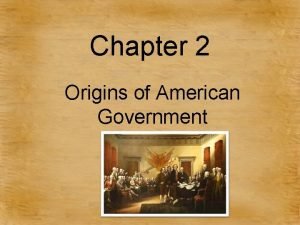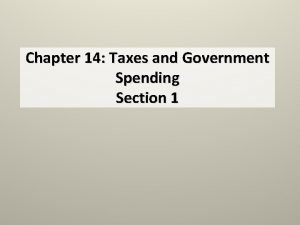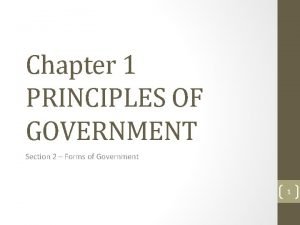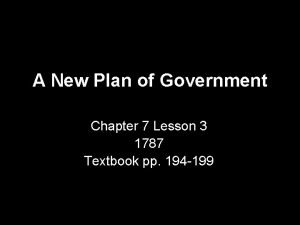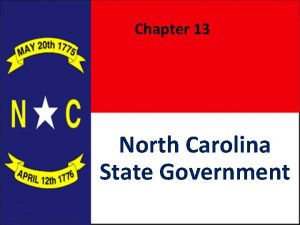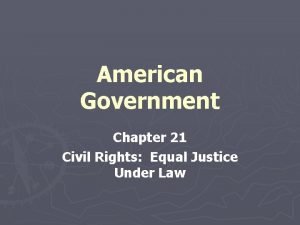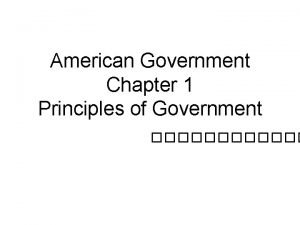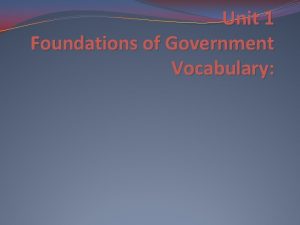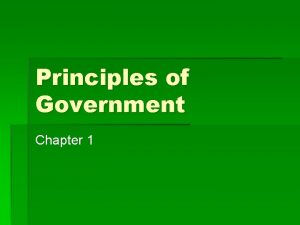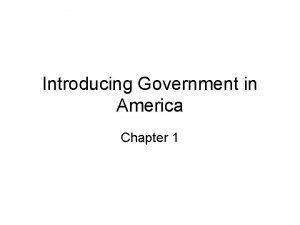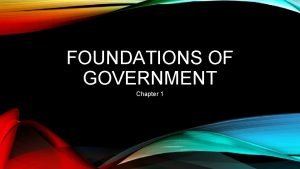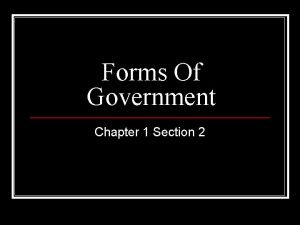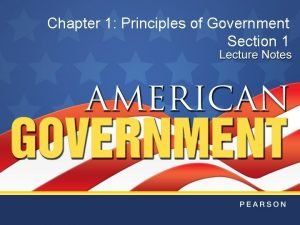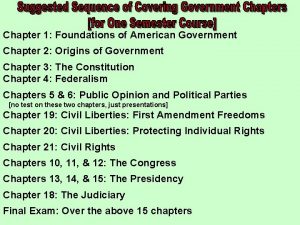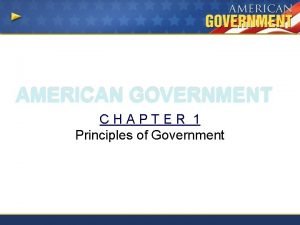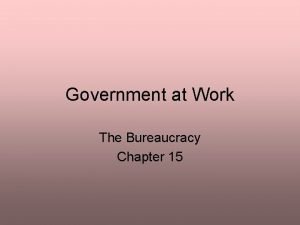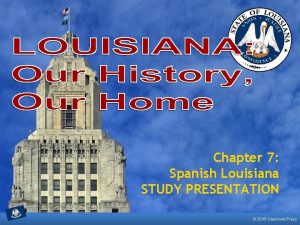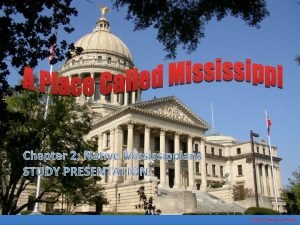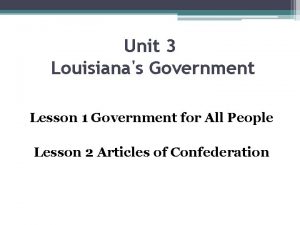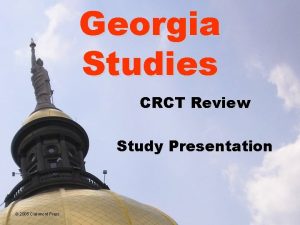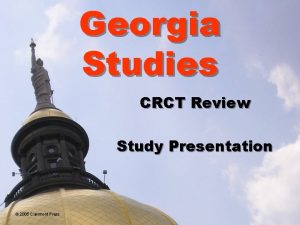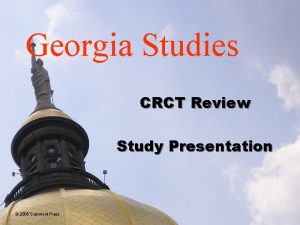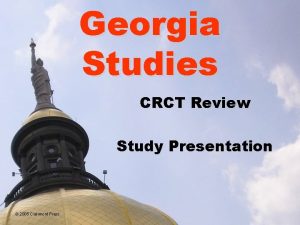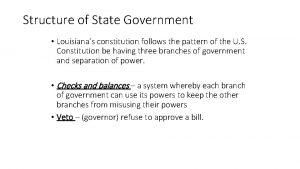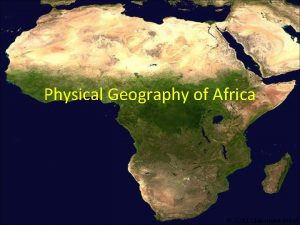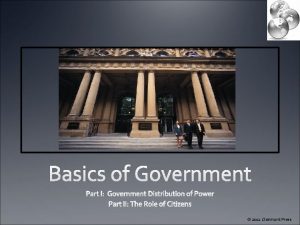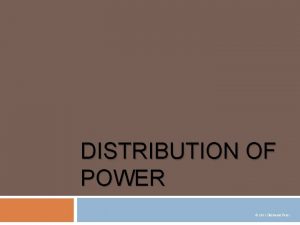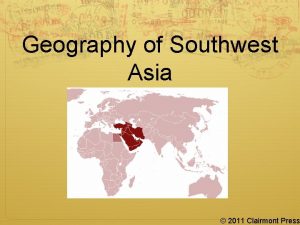Chapter 4 Louisianas Government STUDY PRESENTATION 2015 Clairmont


















































- Slides: 50

Chapter 4: Louisiana’s Government STUDY PRESENTATION © 2015 Clairmont Press

Section 1: From Colony to Democracy Section 2: Structure of State Government Section 3: Local Governments Section 4: Citizens and Government

Section 1: From Colony to Democracy Ø Essential Question: • Which factors influenced the development of Louisiana’s government? 3

Section 1: From Colony to Democracy What terms do I need to know? Ø • • • government Napoleonic Code common law federalism Bill of Rights 4

Introduction Ø Ø Government is the way a community is organized. It is the government’s job to make and carry out laws. There are different types of governments. During the colonial era, Louisiana was a monarchy, which means that it was ruled by a king. After 1803, it slowly became a democratic government, which means that the power of the government rests with the citizens. 5

The History of Louisiana Government Ø Ø The Napoleonic Code was a set of civil laws made by Napoleon for France, which influenced Louisiana’s first civil code. Civil laws set the ground rules for how individuals interact with each other. In 1803, the British system of common law was introduced to Louisiana and influenced criminal laws. When Louisiana became a democracy, the idea of citizens running the government was new. 6

Foundations of Government Ø Ø The constitution of a government explains a government’s purpose, organizations, and powers. A constitution is the most important statement of a government. Each level of government has its own powers and responsibilities given by the U. S. Constitution and the Louisiana Constitution. The U. S. Constitution and the Louisiana Constitution must work in harmony together. 7

The United States Constitution Ø Ø Ø The U. S. Constitution explains which powers belong to both the federal and state governments. Federalism, which is the separation of federal and state powers, is important for the government. The Bill of Rights are the first ten amendments of the U. S. Constitution. The tenth amendment discusses the reserved powers doctrine. Click to view the Constitution of the United States 8

The State Constitution Ø Louisiana has had ten constitutions. Ø The present Louisiana Constitution (1974) follows the U. S. Constitution more closely than any of our earlier state constitutions. Ø Like the U. S. Constitution, it contains a Bill of Rights that guarantees citizens selfdetermination, equal treatment under the law, and freedom from discrimination. Ø Louisiana’s present constitution is more like a general framework for government than earlier versions. Click to view the first Louisiana state constitution (1812) 9

Section 2: Structure of State Government Ø Essential Question: • How is power divided between the three branches of government in Louisiana? 10

Section 2: Structure of State Government What terms do I need to know? Ø • • • checks and balances special session reapportionment conference committee felony misdemeanor appeal jury grand jury severance taxes gaming 11

Introduction Ø Louisiana’s Constitution divides the government into three branches. Ø By dividing powers among these branches, checks and balances are made. Ø Examples of these powers would be the veto, canceling a veto, and the judicial review. Louisiana State Capitol Building 12

Louisiana’s Three Branches of Government Louisiana Constitution Executive Branch Governor, Lt. Governor, Secretary of State, Attorney General, and more Legislative Branch Senators & Representatives Judicial Branch Louisiana Supreme Court and lower courts 13

Executive Branch Ø Ø This branch enforces laws passed by the legislature. The governor is the head of this branch. Six other officials are elected by statewide elections, like the lieutenant governor and the secretary of state. Each position has its own requirements and responsibilities. Louisiana’s Executive Branch of Government 14

Ø Ø Governor To become governor of Louisiana, candidates must meet several criteria, including being at least 25 years old, a U. S. citizen, and a resident of Louisiana for at least 5 years. The governor is elected to a four-year term and can serve two back-to-back terms. One of the governor’s most important duties is to prepare the state budget and submit it to the legislature. The governor can also call upon special sessions of legislature when extreme problems occur. Office of the Governor 15

Lieutenant Governor Ø Ø Ø The lieutenant governor of Louisiana is similar to the vice president of the United States. The lieutenant governor can act temporarily as governor if needed. Other duties of the lieutenant governor include overseeing many state functions, like the Department of Culture, Recreation, and Tourism. 16

Attorney General Ø Ø Ø The attorney general is the state’s head legal official and runs the state’s Department of Justice. The attorney general’s office provides legal advice and representation to the state’s departments, agencies, boards, and commissions, and to statewide elected officials. The attorney general also defends Louisiana laws if they are challenged in the federal courts. 17

Secretary of State Ø Ø Ø The secretary of state is the chief election officer for Louisiana, and leads the Department of State. The department administers the election laws passed by the legislature. The secretary of state is the keeper of the Great Seal of the State of Louisiana. The seal is used to give official approval to state documents. 18

Treasurer Ø Ø Ø The state treasurer is the head of the Department of Treasury. The Department of the Treasury is in charge of the state’s money and keeps records of the state’s income and expenses. The state treasurer is required to prepare and present a yearly financial report to the governor and the legislature one month before each regular session of the legislature begins. 19

Other Elected Officials Ø Ø Louisiana voters elect two additional members of the executive branch: the commissioner of agriculture and the commissioner of insurance. The members of two other boards are elected: the Public Service Commission and the state’s Board of Elementary and Secondary Education (BESE). 20

Legislative Branch Ø Ø Like the U. S. Congress, Louisiana’s legislature is divided into two parts, which is known as bicameral. Having two chambers creates a balance of power between the chambers. Louisiana’s Legislative Branch of Government 21

Legislative Membership Ø Ø The Louisiana legislature has 144 members: 39 senators and 105 representatives. Each member of the legislature is elected from a geographic district based on population. A U. S. Census, the official count of each state’s population, occurs every ten years and is used to review district populations. If population numbers have changed, revising district boundaries might occur. This is called reapportionment. Click to see legislative maps 22

State Legislators Ø Like the governor, legislators must meet certain criteria, including being at least 18 years old and a resident of their district for at least one year. Ø Legislators are elected for 4 year terms. Ø In 1995, voters in Louisiana approved a term limit of three back -to-back terms for legislators. 23

Legislative Sessions Ø Ø Ø The legislature meets every year. In odd-numbered years, the legislature meets for 45 days during a 60 day period. Tax bills can only be passed in odd-numbered years. In even-numbered years, the legislature meets for 60 days over an 85 day period. Members of each chamber elect officers to preside over the sessions. The House of Representatives elects a speaker of the House. In the state Senate, the elected leader is called the president of the Senate. 24

Making Laws Ø Ø Of the 2, 500 bills introduced in each session of the legislature, only about one-third become laws. Legislative committees study and debate proposed laws. Once a bill is introduced it has to be approved by the chambers and the governor before becoming laws. If different bill forms are liked in different chambers, a conference committee will work out the differences. 25

Judicial Branch Ø Ø This branch interprets and applies the constitution and laws of the state. It also protects the rights of citizens. Louisiana’s Judicial Branch of Government 26

Civil and Criminal Law Ø Ø The laws of Louisiana are divided into 2 categories: civil law and criminal law. Civil laws deal with how people interact with each other. Criminal laws protect society from wrongdoings. Serious crimes, like murder and armed robbery, are called felonies. Less serious crimes, like speeding, are called misdemeanors. There are many important jobs in this branch, such as sheriffs, police, city marshals, and district attorneys. 27

Louisiana’s Court System Ø Ø Louisiana’s court system has 3 levels: 43 District Courts, 5 Courts of Appeal, and the Louisiana Supreme Court. District Courts are the main trial courts of the state, listening to both civil and criminal cases. The next step in the justice system would be to appeal, or to take to a higher court, a ruling in the Court of Appeals. If a case escalates enough, it may be taken to the Louisiana Supreme Court. 28

Juries Ø Ø Ø A person accused of a crime has the right to be tried before a jury of peers (persons of equal standing in society). A jury is a group of citizens who hear evidence on a legal case and make a decision based on the evidence. Citizens may also be called to serve on a grand jury. A grand jury is made up of twelve citizens who serve for six months. 29

Funding State Government Ø Ø Ø Governments must have money to function. All governments get their money (called revenue) in a variety of ways. Knowing how much money is needed starts with a detailed plan. 30

The State Budget Ø Ø Ø A budget is needed to plan how to acquire and spend money. This budget is put together by the governor. The Louisiana Constitution requires a balanced budget, which means that the state cannot spend more money than it takes in. 31

Taxes Ø Ø Much of a state’s revenue comes from taxes, which are amounts paid by citizens to their governments to support the government and its services. In Louisiana, the sales tax is the largest single source of revenue. Louisiana also collects severance tax, which is an amount charged for severing (removing) natural resources. Other types of taxes include property tax and income tax. 32

Other Sources of Revenue Ø Ø Louisiana receives revenue from a variety of fees charged for certain kinds of government-issued items like drivers’ licenses or business licenses. Oil and gas royalties (share of the profit) are another source of income. The federal government is also an important source of state revenue. Gaming, the name for legal gambling, is another large revenue source. 33

Section 3: Local Governments Ø Essential Question: • How does the parish system of local government work? 34

Section 3: Local Governments What terms do I need to know? Ø • • parish police jury home rule municipality 35

Introduction Ø Ø Citizens are most likely to interact with government at the local level. In Louisiana, the units of local government are parishes, municipalities, and special districts. 36

Parish Government Ø Ø The parish is the primary local government division. Louisiana is divided into 64 parishes. Louisiana is the only state in the nation that has parishes and parish seats rather than counties or county seats. Parish government is a legacy from Spanish colonial rule, when government divisions were based on districts created by the Catholic Church. Ouachita Parish Courthouse 37

Louisiana Parish Map 38

Police Juries Ø Ø Police juries pass local laws for their parishes as well as build and maintain roads and public buildings. Police juries can have between 3 and 15 elected members. Sometimes police juries create special districts to perform specific services, like school, fire protection, levee, and water districts. The sheriff is elected to be the chief law enforcement officer and tax collector in the parish. 39

Other Types of Parish Government Ø Ø Ø The Louisiana Constitution of 1974 gave more authority to local governments. The power given to political subdivisions to govern their own affairs is known as home rule. Parishes with a home rule charter are allowed to organize in a form other than the police jury. These other forms of government include having an elected parish council and a parish president, or an elected parish council that is empowered to select a parish administrator (manager). 40

Municipalities Ø Ø Ø Municipalities are the cities, towns, and villages of different sizes, each being ranked by population. People who live in rural areas outside a city or town have no municipal government. A municipality elects a mayor and a council or a group of commissioners. 41

School Boards Ø Ø Most local school systems share boundaries with their parish. School board members are elected from a district based on population in the parish and serve a 4 year term. School boards are special forms of government not linked with the parish government, but they are more closely regulated by the state. Each board chooses a superintendent to oversee operations of the school system. 42

Section 4: Citizens and Government Ø Essential Question: • What are the different ways citizens can participate in the Louisiana government? 43

Section 4: Citizens and Government What terms do I need to know? Ø • • open primary system political party lobby propaganda 44

Introduction Ø Ø In a democratic government, the main focus is the citizens, their rights, and their responsibilities. While a citizen may have many rights, they also have many responsibilities. Citizens are also responsible for their actions and must respect the rights of others. Rights of citizens include: freedom of speech, freedom of religion, and the right to vote. 45

Voting and Elections Ø Ø There are several requirements to meet before a citizen can be a registered voter. Statewide elections in Louisiana are held in 2 stages. The first stage is an open primary system, when all of the candidates, no matter what political party they represent, compete in the first (or primary) election. After the primary election, the two candidates with the most votes move on to a runoff election, where the one with the most votes wins. 46

Political Parties Ø Ø Ø Political parties are organizations who share ideas on how the government should work and have joined together. There are two major parties around today: the Democratic Party and the Republican Party. Historically, people in Louisiana have often voted on the basis of local issues or identities rather than on the basis of party affiliation. 47

Campaigns Ø Ø Ø Many candidates organize campaigns to gain attention from voters, from television commercials to Internet ads. Running political campaigns has become very expensive because buying time for advertisements on television is quite costly. Fund-raising is an important part of the modern campaign process. 48

Lobbying and Organizing Ø Ø Every citizen has the ability to attempt to influence legislators about issues, which is called lobbying. People who disagree on an issue sometimes accuse their opponents of creating propaganda. Propaganda is information spread widely in order to promote or discourage a particular proposal or political point of view. Organization of many people has become more efficient through social media. 49

Image Credits Slide 1: Chris Miceli on Wikimedia Commons, Public Domain; Slide 2: Ken Thomas (alligator); Jillian. E (Chicot State Park); City of Monroe, LA; Albert Herring (Mardi Gras), Lael Butler (pelican); Jesper Rautell Balle (cajun meal); Susan Adams (Chemin-a-Haut State Park) on Wikimedia Commons; Slide 12: Reginald Lankford, Clairmont Press; Image Credits Slide: Edd Prince on Wikimedia Commons; maps copyright Clairmont Press; all others public domain Shown here: Fontainebleau State Park Return to Main Menu 50
 Andra prems
Andra prems Clairmont press
Clairmont press Clairmont press
Clairmont press State government entities certified agreement 2020
State government entities certified agreement 2020 Chapter 1 principles of government study guide answer key
Chapter 1 principles of government study guide answer key Iso 9001:2015 awareness training ppt
Iso 9001:2015 awareness training ppt Iso 9001:2015 management review meeting presentation ppt
Iso 9001:2015 management review meeting presentation ppt National government vs federal government
National government vs federal government The systematic study of the state and government
The systematic study of the state and government Unit 1 government study guide
Unit 1 government study guide Fetal brow
Fetal brow Leopold's maneuver
Leopold's maneuver Yelp elite benefits
Yelp elite benefits Lbo case study
Lbo case study Yelps mission
Yelps mission Conclusion for case study
Conclusion for case study Evaluation criteria for case study presentation
Evaluation criteria for case study presentation Creek 2003 occupational therapy process
Creek 2003 occupational therapy process Ecological study vs cohort study
Ecological study vs cohort study Retrospective cohort study vs prospective cohort study
Retrospective cohort study vs prospective cohort study Method study in management
Method study in management Study less study smart
Study less study smart Phytogeography region of india
Phytogeography region of india Distinguish between motion study and time study
Distinguish between motion study and time study Distinguish between time study and motion study
Distinguish between time study and motion study Social responsibility of business and government chapter 4
Social responsibility of business and government chapter 4 Flocabulary checks and balances
Flocabulary checks and balances Chapter 2 american government
Chapter 2 american government Chapter 14: taxes and government spending section 1
Chapter 14: taxes and government spending section 1 Chapter 5 vocabulary government
Chapter 5 vocabulary government Chapter 2 lesson 1 government in colonial america
Chapter 2 lesson 1 government in colonial america Chapter 14 taxes and government spending
Chapter 14 taxes and government spending Forms of government chapter 1 section 2
Forms of government chapter 1 section 2 Guided reading activity foundations of government lesson 1
Guided reading activity foundations of government lesson 1 Chapter 2 origins of american government vocabulary
Chapter 2 origins of american government vocabulary Lesson 3 a new plan of government answer key
Lesson 3 a new plan of government answer key Chapter 2 origins of american government answer key
Chapter 2 origins of american government answer key Chapter 2: origins of american government worksheet answers
Chapter 2: origins of american government worksheet answers Chapter 13: north carolina state government
Chapter 13: north carolina state government Chapter 1 principles of government
Chapter 1 principles of government Government chapter 21 diversity and discrimination
Government chapter 21 diversity and discrimination Principles of government chapter 1 answers
Principles of government chapter 1 answers Ultimate frisbee vocabulary
Ultimate frisbee vocabulary Principles of government chapter 1
Principles of government chapter 1 Define politics
Define politics Chapter 1: foundations of government pdf
Chapter 1: foundations of government pdf Chapter 1 section 2 forms of government
Chapter 1 section 2 forms of government Chapter 1 principles of government
Chapter 1 principles of government Foundations of government (chapter 1 test form a)
Foundations of government (chapter 1 test form a) Chapter 1 principles of government
Chapter 1 principles of government Chapter 15 government at work the bureaucracy
Chapter 15 government at work the bureaucracy

